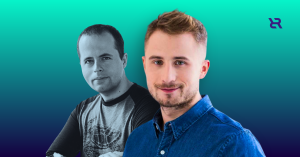In the competitive world of tech startups, good design can be the key to standing out and scaling up.
Brandly is already positioning itself as a leader in this arena, leveraging 12 design awards, over 75 success stories, and a global footprint with exhibitions in 10 countries. Through its design expertise, the company has supported numerous digital businesses in emotionally connecting with customers and establishing themselves as industry frontrunners.
In the following interview with Brandly’s leadership, Zlatina Petrova and Nelio de Barros, we explore their latest achievements and how they’re planning to use AI to transform user experience design, from creating highly personalized interfaces to solving major UX/UI challenges.
First of all, what are the achievements of Brandly in 2023 that you’re most proud of?
In 2023, we hit some milestones at Brandly that we’re super excited about. We launched a new branch of the company called Brandly Digital, focused on product design (UX and UI) for AI digital products. Some of the projects we tackled in that area include an AI platform for Germany’s Copernicus satellite data program, a chatbot for an Australian legal institute, and an AI personal assistant, that helps managers and companies streamline their tasks.
On top of that, we focused more on helping startup companies with their branding and we’re happy to share their success. One of them raised $5 million, and another even went public.
How did the rise of generative AI and LLMs change the way you operate?
Designing apps with an intelligence layer and the ability to generate new answers on the fly brings a whole new set of challenges and opportunities. Now, we can create highly personalized experiences for each user, putting them at the heart of the design process, unlike our previous approach that catered to broader persona types.
Generative AI and Large Language Models (LLMs) have been game-changers for us at Brandly. They’ve revolutionized our operations, making our processes more efficient and our user experiences more personalized. By integrating LLMs, we’ve automated tedious, time-consuming tasks, allowing us to concentrate on innovation.
LLMs have had a massive impact on content creation and customer interactions. We can now produce personalized content at scale, tailor communications to individual preferences, and enhance user engagement with timely, relevant interactions. This not only boosts efficiency but also enriches the user experience, adding more value to our community.
Moreover, LLMs’ ability to quickly and accurately analyze large datasets has given us deeper insights into customer behavior and preferences. This data-driven approach informs our product development and marketing strategies, making them more aligned with what our customers actually need.
In short, embracing generative AI and LLMs has made us more innovative and responsive, leading to better outcomes for our users and our business.
How have the needs of your customers evolved in the past year and how is Brandly evolving to better serve them?
We see a huge interest in AI, but still a lot of caution on how clients are approaching it. For now the examples where AI became popular are mostly chatbots and assistants, so that is what most clients are requesting, but AI is not limited to that. We can literally reinvent the wheel if we think about how many tools on the web work and serve the users nowadays.
The game is considerably more technical now after AI entered the game, so UX disciplines need to truly understand how the technology works to know what is possible to do, and test if those are solutions that are fit for the needs of the users.
On the other hand, clients also need a partner helping them across this new paradigm of technological advancements, and to evolve their products beyond the boundaries of what was done before without AI.
When designing for AI-based products, what key principles do you follow to ensure usability and a positive user experience?
If I can reduce it to 2 key principles it would definitely be personalization and trust.
Personalization because now we are able to design apps as if they are a real concierge to each user, adapting and understanding each user’s specific needs, instead of trying to address the needs of a larger grouped type of persona. If before people had to adapt to software, the new paradigm is that the software adapts to people.
Trust is about each user understanding how the business/app behaves, what is a human component replying, what is AI, and when each of these elements is interacting and representing the business. We are virtually at a point where the average user won’t be able to see the difference between AI-generated and human, but it is important to establish that contrast so we don’t have negative outcomes and fallout.
How can companies ensure their brand identity remains strong, consistent, and standing out from the crowd given that now with AI there will be more content out there?
We believe in the magic that happens when human creativity meets AI efficiency. It’s vital to oversee and refine AI outputs, blending them with human insights to ensure they truly reflect our brand’s values and resonate with our community. AI’s ability to deeply analyze data helps us understand our audience’s evolving needs with unmatched precision, offering them personalized experiences that not only meet but anticipate their desires.
Another crucial aspect for brands to consider is transparency and ethics. Companies should be open about using AI in their brand development, making sure their community knows that while they’re leveraging cutting-edge technology, they’re also upholding the highest ethical standards. This openness preserves trust and safeguards interests.
The core of a brand doesn’t change with the introduction of AI, but businesses need a solid understanding of how the technology works and the boundaries they should maintain. Once defined, working with AI is like adding another “human” element to the team. We have to train it to represent the brand accurately. The key difference is that this new AI partner can cross-examine information infinitely better to serve customers. As long as customers know what is AI-generated and what is human, the brand will maintain its integrity.
From your perspective, what’s the future of personalization in UX in the next few years, especially with the new opportunities unlocked by advancements in AI?
One of the core stones of UX currently is to create “personas” and conduct usability tests to design an app that serves as well as possible for some specific types of users. We call this “user” centered design, but in this case, the “user” is not an individual but rather a group that shares similar characteristics.
With the introduction of AI, the field of UX will have to adapt, because now it’s actually possible to design something for each individual user, and for example have an app that behaves in 1000 different ways, for 1000 different users, while not having to code different versions for each particular person.
If nowadays we think about a website interface that serves content to users, after introducing AI we can think of a new paradigm where we have a system that generates interfaces and new content according to different parameters that change over time and according to the circumstances.
Can you tell us more about your plans to productify your services and offer generative AI design capabilities to your customers?
This is the million-dollar question for us, because since we are right at the start of this new era, there are multiple possibilities, and many of the services we are currently offering could be transformed into products. On the other hand, our unique advantage is also a close perspective and experience that we have with local markets, and our ability to bring insights to our clients that are (at least for now) not yet possible to fully automate and generate through AI.
We think about the future and the possibilities the AI world offers, and one of the possible opportunities for us is to use AI’s potential to revolutionize design workflows enabling businesses to innovate faster and more effectively. Developing AI-driven tools that automate the initial phases of the design process is a great start. It could generate a variety of design elements based on brief inputs about brand guidelines, desired aesthetics, and user functionality requirements. This not only speeds up the creation process but also ensures design consistency across various platforms and touchpoints.
For us, it’s about making elite design capabilities accessible, and transforming good projects into great ones by enhancing user interaction and satisfaction. By integrating AI into our services, we’re not just following the trends—we’re creating them, and we’re excited to lead businesses into this new era of digital design.
What are actually some major challenges in UX/ UI/ Web Design that AI can help solve in the next few years?
In the next few years, AI is set to revolutionize UX/UI and web design, tackling some of the industry’s biggest challenges. One of the most exciting prospects is AI’s ability to supercharge personalization in digital products. By leveraging extensive user interaction data, we can create uniquely tailored experiences that cater to diverse user needs, boosting engagement and satisfaction. What was once a dream is now within reach, thanks to AI.
AI is also streamlining the design process by automating routine tasks like creating wireframes and prototypes. This not only speeds up the entire design cycle but also frees our creative team to focus on more innovative and complex challenges. This shift is crucial, as it allows designers to unleash their full creative potential without getting bogged down by repetitive tasks.
In addition, AI plays a critical role in ensuring accessibility, a must for inclusive design. It can automatically assess and adjust designs to meet accessibility standards, ensuring our digital products are usable by everyone, including those with disabilities. This capability is vital for fostering an inclusive digital environment.
AI also enhances our ability to respond to user feedback in real time. With AI tools, we can continuously refine and adapt our designs to meet evolving user expectations. The predictive capabilities of AI go even further, anticipating user behaviors and needs, which helps us create proactive design solutions that enhance user experiences and reduce the need for future redesigns.
Personalized experiences for each user, boosted engagement and conversions, automated repetitive design tasks, and ensured accessibility for all users, including those with disabilities—these are just some of the ways AI-driven designs are creating more satisfying experiences. This not only increases brand loyalty but also drives innovation in design processes.
What’s your vision for the future development of Brandly in an AI world?
At Brandly, our vision for the future is all about transforming brands through cutting-edge design and technology. We’re not just keeping up with the AI era; we’re set on redefining it. We want to revolutionize how individuals and companies perceive and interact with UX design, pushing the boundaries of what’s possible.
We’re especially excited about developing our own generative AI product. This isn’t just another service; it’s a core part of our future strategy. By focusing on UX for AI products, we aim to deliver unprecedented value to our clients and the global digital landscape, ensuring Brandly stays at the forefront of design innovation.
+++To learn more about Brandly, check their website.
+++For more on the most innovative AI companies in CEE, check The Recursive report








